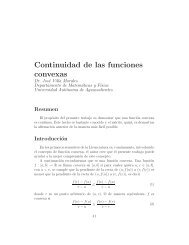Chapter 4 Linear Differential Operators
Chapter 4 Linear Differential Operators
Chapter 4 Linear Differential Operators
Create successful ePaper yourself
Turn your PDF publications into a flip-book with our unique Google optimized e-Paper software.
134 CHAPTER 4. LINEAR DIFFERENTIAL OPERATORS<br />
we see that ψ0 is an eigenfunction of H with eigenvalue 1, and so an eigenfunction<br />
of QQ † with eigenvalue 2. Hence Q † ψ0 is an eigenfunction of Q † Q<br />
with eigenvalue 2 and so an eigenfunction H with eigenvalue 3. Proceeding<br />
in the way we find that<br />
ψn = (Q † ) n ψ0<br />
is an eigenfunction of H with eigenvalue 2n + 1.<br />
1<br />
− ∂xe 2 x2,<br />
we can write<br />
where<br />
Since Q † = −e 1<br />
2 x2<br />
(4.106)<br />
1<br />
−<br />
ψn(x) = Hn(x)e 2 x2<br />
, (4.107)<br />
Hn(x) = (−1) n dn<br />
x2<br />
e<br />
dx<br />
n e−x2<br />
(4.108)<br />
are the Hermite Polynomials.<br />
This is a useful technique for any second-order operator that can be factorized<br />
— and a surprising number of the equations for “special functions”<br />
can be. You will see it later, both in the exercises and in connection with<br />
Bessel functions.<br />
Exercise 4.6: Show that we have found all the eigenfunctions and eigenvalues<br />
of H = −∂ 2 x + x 2 . Hint: Show that Q lowers the eigenvalue by 2 and use the<br />
fact that Q † Q cannot have negative eigenvalues.<br />
Problem 4.7: Schrödinger equations of the form<br />
− d2 ψ<br />
dx 2 − l(l + 1)sech2 x ψ = Eψ<br />
are known as Pöschel-Teller equations. By setting u = ltanh x and following<br />
the strategy of this problem one may relate solutions for l to those for l−1 and<br />
so find all bound states and scattering eigenfunctions for any integer l.<br />
a) Suppose that we know that ψ = exp − x<br />
u(x ′ )dx ′ is a solution of<br />
<br />
Lψ ≡ − d2<br />
<br />
+ W (x) ψ = 0.<br />
dx2 Show that L can be written as L = M † M where<br />
<br />
d<br />
M = + u(x) , M<br />
dx † <br />
= − d<br />
<br />
+ u(x) ,<br />
dx<br />
the adjoint being taken with respect to the product 〈u, v〉 = u ∗ v dx.




